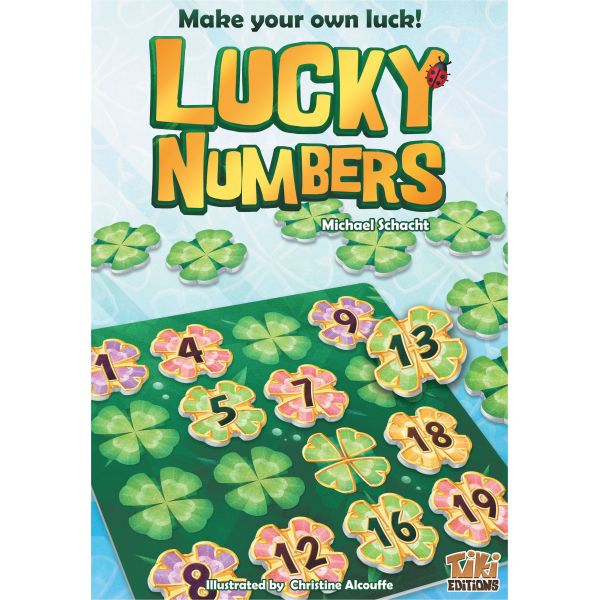Draw Clovers to Find Your Lucky Numbers

TIKI Editions revises designer Michael Schacht’s strategy game with a slightly updated look and new scenarios for solo players.
Gameplay
Lucky Numbers is a 15-20 minute game of luck and strategy that has little set up and rules. Play begins with each player grabbing a game board, making sure the ladybug is placed in the lower right. For each player, grab a set of colored clovers (numbered 1-20), shuffle them, and then place them face-down in a stack. The color does not matter, outside of ensuring that a complete set for each player has been selected. Players will then draw four clover tiles and place them diagonally in each of the golden spaces on their player boards.
The first player will draw a tile from the face-down stack and place the clover on their board, or leave it face-up and place it in the middle of the table. Players will be trying to form ascending rows and columns from the values on each clover tile.This can be tricky depending on what is drawn or available in the face-up area, and having two of the same values adjacent to each other in any row or column is not allowed.
From now on, each player can choose to take a clover from the face-down stack to add it to their tableau or to take a face-up clover. They may place the tile in an empty space that fits the rules of creating ascending values in each row and column or use it to replace a clover on their game board, placing the evicted tile in the face up row.
The player who completely fills their game board with correctly ascending rows and columns is the winner. If this doesn’t happen after the last available face-down tile has been revealed, the player with the fewest empty spaces is declared the winner.

Photo provided by the publisher
Review
Despite its ease of play and rules, Lucky Numbers is beholden to the luck of the draw. This isn’t to say players are unable to strategize, especially with a row of face-up tiles available, but it’s hardly predictable to know what’s going to turn up on the next tile reveal or what will be available during one’s turn from the face-up tiles. But that’s the fun of a game such as Lucky Numbers: the art of surprise and overcoming it as best as possible.
The rules offer a few variants on play as well, to help increase difficulty or to provide insight into tournament style play, considering games are quick. Where the new update really shines is the solo variant. Lucky Numbers, even with 4 players, is a bit solitaire due to each person working on their own boards, and it makes little sense to take a clover that could benefit someone else if it doesn’t work for their own boards. Which is why the solo variant is great.
The solo variant offers 40 scenarios, each showing players how to set up a full board with specifically-placed numerals scattered across the board. The object is to exchange tiles by following specific rules (examples include switching tiles that are immediately adjacent to each other or switching tiles in the same row or column that are on the edges) in a set number of moves. The first few scenarios are simple and meant to familiarize solo players with these limited rule sets, but as the difficulty increases so does the number of moves. Yet, they never seem to feel like enough.
All in all, Lucky Numbers is the perfect puzzle game for young families and solo strategists alike. Its simplicity in set up and rules makes it easy to bust out during family gatherings or during lengthy virtual meetings. It can be played at the dining table or in the backseat of the car during road trips. It is a no frills game that has simple, but attractive graphic design and is accommodating to the gaming situation.
Pros: Easy to set up and play, each game is different due to the luck of the draw
Cons: Luck is a turn off for some gamers, early solo scenarios are too easy









